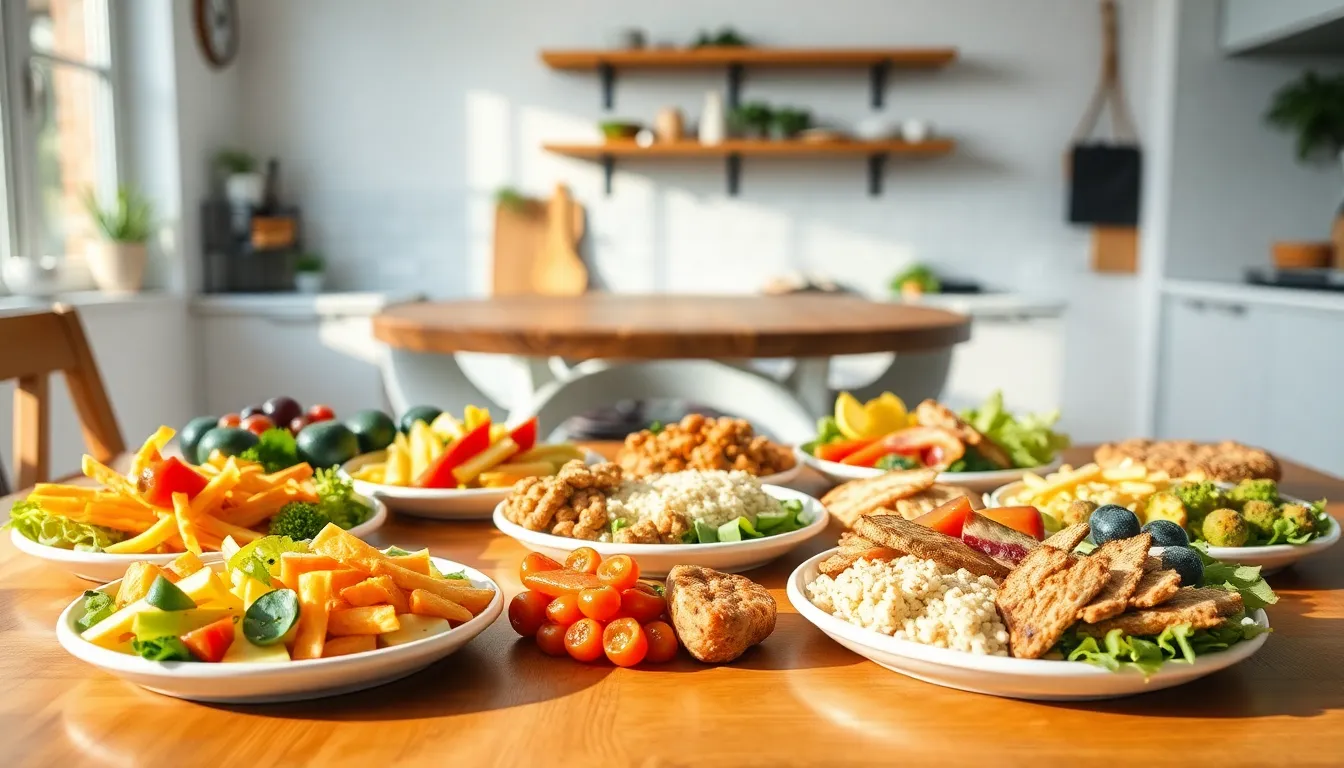In a world overflowing with food options and endless buffet lines, the struggle to maintain a balanced diet can feel like an Olympic sport. Enter the food portion plate—the unsung hero of healthy eating. This handy tool helps transform chaotic meal times into organized culinary experiences, ensuring every bite counts without the need for a degree in nutrition.
Picture this: a plate that practically shouts, “Hey, you! Yes, you with the fork! Fill me wisely!” With designated sections for proteins, grains, and veggies, it’s like a personal trainer for your meals, guiding you toward a healthier lifestyle while keeping your taste buds happy. So, if you’re ready to conquer portion control and make your plate a masterpiece, let’s dig into the delightful world of food portion plates and discover how they can revolutionize the way we eat.
Table of Contents
ToggleWhat Is a Food Portion Plate?
A food portion plate is a tool designed to help manage meal sizes while promoting balanced nutrition. These plates contain designated sections for various food groups, such as proteins, grains, and vegetables. The structure of each plate simplifies meal preparation by providing clear visual guides that prevent overeating.
Plates typically feature three or more compartments to encourage filling the largest section with vegetables. This approach helps prioritize healthy options. People can fill the smaller sections with proteins and grains, ensuring a balanced intake.
Utilizing a food portion plate reduces the need for precise measuring tools, making it easier for individuals to control portion sizes without calorie counting. Serving food on these plates can make meals visually appealing, reinforcing healthier eating habits. Families and individuals benefit from this method by simplifying their choices.
Adopting food portion plates may also assist in preventing common issues like overeating and unhealthy snacking. Research indicates that visual cues play a significant role in appetite control. When presented with appropriately sized portions, people tend to eat less while still feeling satisfied.
Incorporating a food portion plate into daily meals can be a straightforward way to enhance dining experiences, particularly for those seeking a healthier lifestyle. These plates serve as practical solutions that cater to various dietary needs while fitting seamlessly into everyday routines.
Importance of Using a Food Portion Plate


Food portion plates play a crucial role in promoting healthy eating habits. They help individuals manage meal sizes effectively, leading to a balanced diet.
Health Benefits
Health benefits of food portion plates are numerous. Controlling portion sizes reduces the risk of overeating, which helps maintain a healthy weight. Studies show smaller plates often lead to smaller servings, directly influencing calorie intake. Monitoring portions can also assist in preventing chronic diseases, such as diabetes and heart disease. This method encourages users to fill larger sections with vegetables, increasing daily vegetable consumption. Higher vegetable intake contributes to improved overall health, enhancing nutrient density in meals.
Nutritional Balance
Nutritional balance becomes easier with food portion plates. Each plate typically features designated sections, promoting the inclusion of proteins, grains, and vegetables. Users gain a clearer understanding of serving sizes, ensuring meals are well-rounded. Research supports the idea that balanced meals improve energy levels and overall well-being. Portion plates encourage variety in food choices, which can lead to a more diverse nutrient profile. When individuals visualize appropriate serving sizes, it fosters mindful eating habits, ultimately enhancing dietary quality.
How to Use a Food Portion Plate
Using a food portion plate involves simple strategies for maintaining balanced meals. These plates guide users in serving appropriate food amounts without needing extensive calculations.
Proper Measurements
Each section of the food portion plate corresponds to specific food groups. Proteins, grains, and vegetables fit into designated areas, helping users visualize recommended serving sizes. Heaping vegetables fills the largest section, promoting greater vegetable intake. For instance, filling one-quarter with lean proteins and another quarter with whole grains offers a sensible approach to meal planning. Sticking to these measurements helps prevent overeating while ensuring a diverse nutrient intake. Users can find their daily requirements in MyPlate resources, which reinforce the effectiveness of using these plates for meal management.
Customizing for Dietary Needs
Customizing food portion plates accommodates individual dietary preferences and restrictions. Gluten-free grains can substitute standard options, ensuring all users enjoy balanced meals. Vegetarians can focus on plant-based proteins while filling sections with a variety of legumes. Choosing healthy fats, such as avocados or nuts, allows users to manage nutrient quality effectively. Adjusting vegetables based on seasonal availability maintains variety and freshness in meals. Individuals following specific diets, like keto or Mediterranean, can easily adapt portion plates, promoting adherence to their nutritional goals while simplifying meal preparation.
Choosing the Right Food Portion Plate
Selecting the right food portion plate involves careful consideration of materials and design to meet individual dietary needs. By prioritizing aspects such as functionality and aesthetics, users can enhance their meal experiences.
Material Considerations
Material choice significantly affects the durability and usability of a food portion plate. Ceramic plates are sturdy and offer a stylish appearance, making them suitable for formal dining. Melamine provides a lightweight, break-resistant option ideal for everyday use, while bamboo is an eco-friendly alternative. Silicone plates, known for their flexibility, are great for children and easy to clean. Each material has its advantages, so evaluating personal preferences is essential when making a choice.
Design Options
Design impacts not only visual appeal but also functionality of food portion plates. Plates with multiple compartments encourage balanced meal assembly, helping users easily visualize portions. Some designs feature vibrant colors and fun patterns, attracting children to adopt healthier eating habits. Circular plates present a classic option, while rectangular or square designs allow for more creative food arrangements. Customization options, such as section sizes and plate shapes, enhance adaptability, catering to various dietary requirements and personal tastes. Choosing the right design promotes not only nutrition but also a pleasurable dining experience.
Food portion plates offer a simple yet effective way to promote healthier eating habits. By visually guiding users in meal preparation they make it easier to achieve balanced nutrition without the stress of calorie counting. The structured design encourages an emphasis on vegetables while ensuring a well-rounded intake of proteins and grains.
Adopting food portion plates can lead to mindful eating practices reducing the risk of overeating and supporting weight management. With various materials and designs available these plates can cater to individual preferences and dietary needs. Ultimately they serve as valuable tools for anyone looking to enhance their dining experience while prioritizing health and wellness.





